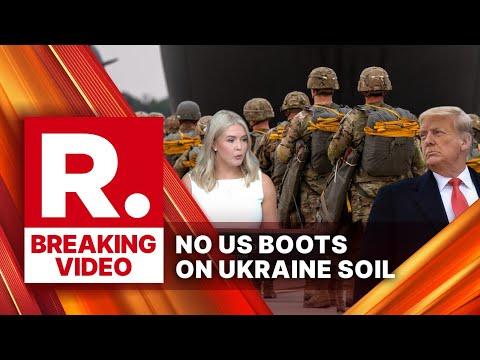Trump Reaffirms US Stance: No Ground Troops to Ukraine Amid Heightened Conflict
Former President Donald Trump has recently reiterated a firm position that the United States will refrain from sending ground combat forces to Ukraine despite the ongoing conflict in Eastern Europe. This declaration comes amid intensifying debates over the extent of American military involvement in the region. Trump emphasized that while direct troop deployment is off the table, the U.S.remains committed to supporting Ukraine through alternative channels such as military aid and intelligence cooperation. This nuanced approach adds a significant viewpoint to the broader discussion on U.S. foreign policy and defense strategy in the face of Russian aggression.
Core Elements of Trump’s Ukraine Policy
- Firm rejection of deploying American ground troops in Ukraine
- Provision of non-combat support including financial aid and defensive weaponry
- Promotion of diplomatic negotiations to de-escalate tensions
- Focus on safeguarding U.S. national security interests
| Policy Aspect | Trump’s Position |
|---|---|
| Ground Troop Deployment | Explicitly opposed |
| Support Mechanisms | Military aid, intelligence sharing |
| Diplomatic Strategy | Encourages dialogue over conflict |
| Risk Mitigation | Prioritizes American security |
NATO and European Allies: Adjusting to the US Ground Troop Stance
The U.S. decision to avoid deploying ground forces in Ukraine inevitably reshapes NATO’s strategic posture in Eastern Europe. This shift places greater responsibility on European member states to bolster their defense capabilities and maintain regional stability. With the U.S. focusing on indirect support, such as intelligence sharing and advanced military equipment deliveries, NATO allies are expected to enhance their military readiness and coordination.
Key consequences for NATO and its partners include:
- Heightened burden on Eastern European militaries: Countries like Poland, Romania, and the Baltic states may need to increase troop deployments and border security measures.
- Acceleration of defense budgets: Many NATO members are likely to expedite military spending to close capability gaps, with some already pledging to meet or exceed the 2% GDP defense spending target.
- Strengthened diplomatic collaboration: Enhanced political dialogue among allies to ensure a unified approach balancing support for Ukraine with broader regional security concerns.
| NATO Focus Area | Anticipated Impact |
|---|---|
| Military Readiness | Increased troop presence in frontline states |
| Resource Allocation | Boosted funding for air defense and cyber warfare units |
| Political Coordination | More frequent strategic consultations and joint exercises |
Diplomatic Initiatives to Counter Russian Advances Without Direct Combat
In the evolving geopolitical habitat, the emphasis has shifted toward diplomatic and economic tools to counter Russian aggression while avoiding direct military confrontation. The United States, alongside its allies, is leveraging multilateral platforms such as the United Nations and NATO to coordinate efforts that include stringent economic sanctions, strategic dialogues, and intelligence sharing.
Current diplomatic strategies encompass:
- Unified sanctions regimes targeting key sectors of the Russian economy to curtail war financing
- Backchannel negotiations aimed at exploring ceasefire possibilities and conflict de-escalation
- Provision of defensive military aid to Ukraine and neighboring countries without deploying combat troops
| Diplomatic Tool | Objective | Expected Result |
|---|---|---|
| Economic Sanctions | Disrupt Russia’s financial and trade networks | Reduce war funding, pressure for negotiations |
| NATO Military Assistance | Supply defensive arms and intelligence | Strengthen Ukraine’s defense without escalation |
| Diplomatic Engagements | Maintain open communication channels | Facilitate peace talks and conflict resolution |
Strategies for Providing Military Support While Avoiding Direct Intervention
Striking a balance between aiding Ukraine militarily and maintaining a non-interventionist policy requires intentional and transparent measures.The U.S. must continue supplying defensive equipment and intelligence to empower Ukrainian forces, while simultaneously prioritizing diplomatic efforts to reduce hostilities. This approach minimizes risks associated with direct combat involvement and respects Ukraine’s sovereignty.
Recommended practices include:
- Restricting military aid to defensive systems to prevent escalation
- Engaging in ongoing diplomatic dialogue with all parties, including Russia
- Investing in humanitarian relief and post-conflict reconstruction initiatives
- Implementing rigorous oversight mechanisms by Congress and self-reliant bodies to ensure accountability and prevent mission creep
| Support Dimension | Non-Interventionist Focus |
|---|---|
| Military Equipment | Defensive, non-offensive technologies only |
| Personnel Deployment | No combat troops stationed abroad |
| Diplomatic Initiatives | Active peace negotiations and conflict management |
| Oversight | Transparent monitoring with clear benchmarks |
Adopting flexible policy frameworks that can adapt to the fluid situation on the ground is essential. By avoiding direct military engagement, the U.S. protects its strategic interests while supporting Ukraine’s sovereignty and responding to global calls for restraint. This model may serve as a precedent for future conflicts where robust support does not necessitate boots on the ground but a comprehensive, responsible approach to international aid and diplomacy.
Conclusion: Navigating the Complexities of US Involvement in Ukraine
As the conflict in Ukraine persists, former President Donald Trump’s reaffirmation that the United States will not commit ground troops adds a critical dimension to the ongoing debate over American engagement. While material and diplomatic support remain pillars of U.S. policy, this stance highlights the delicate balance between aiding an ally and avoiding direct military confrontation. Observers worldwide will be watching closely to see how this position shapes both domestic political discourse and international relations in the coming months.
